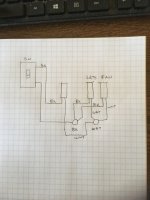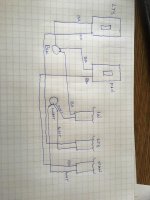Snorp
DIY Junior Member
Hello again folks,
I really appreciate the time and effort and knowledge that you guys have given me before. Here I am, back again with hat in hand.
I'm remodeling a small bathroom - new fan and two led vanity lights (not enough light output from one light).
Old hookup was using one switch which controlled both the old fan and the old lights - both either on or off. Diagram provided - but really not necessary.
LED lights will be connected in parallel to a dimmer switch - yes the leds are dimmable. The fan will be connected to a simple spst switch.
My ignorance is how to connect the 2 wire + gnd house wiring to the 3 wire + gnd transformers contained within the leds.
Google used to be helpful in finding the answer to my question but since they've been playing games with their search algorithm, I've not been able to find the answer to my question.
Any help and or comments would be greatly appreciated.
Regards,
Andy
I really appreciate the time and effort and knowledge that you guys have given me before. Here I am, back again with hat in hand.
I'm remodeling a small bathroom - new fan and two led vanity lights (not enough light output from one light).
Old hookup was using one switch which controlled both the old fan and the old lights - both either on or off. Diagram provided - but really not necessary.
LED lights will be connected in parallel to a dimmer switch - yes the leds are dimmable. The fan will be connected to a simple spst switch.
My ignorance is how to connect the 2 wire + gnd house wiring to the 3 wire + gnd transformers contained within the leds.
Google used to be helpful in finding the answer to my question but since they've been playing games with their search algorithm, I've not been able to find the answer to my question.
Any help and or comments would be greatly appreciated.
Regards,
Andy


